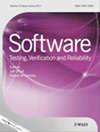Functional test generation from UI test scenarios using reinforcement learning for android applications
IF 1.2
4区 计算机科学
Q3 COMPUTER SCIENCE, SOFTWARE ENGINEERING
引用次数: 12
Abstract
With the ever‐growing Android graphical user interface (GUI) application market, there have been many studies on automated test generation for Android GUI applications. These studies successfully demonstrate how to detect fatal exceptions and achieve high coverage with fully automated test generation engines. However, it is unclear how many GUI functions these engines manage to test. The current best practice for the functional testing of Android GUI applications is to design user interface (UI) test scenarios with a non‐technical and human‐readable language such as Gherkin and implement Java/Kotlin methods for every statement of all the UI test scenarios. Writing tests for UI test scenarios is hard, especially when some scenario statements are high‐level and declarative, so it is not clear what actions should the generated test perform. We propose the Fully Automated Reinforcement LEArning‐Driven specification‐based test generator for Android (FARLEAD‐Android). FARLEAD‐Android first translates the UI test scenario to a GUI‐level formal specification as a linear‐time temporal logic (LTL) formula. The LTL formula guides the test generation and acts as a specified test oracle. By dynamically executing the application under test (AUT), and monitoring the LTL formula, FARLEAD‐Android learns how to produce a witness for the UI test scenario, using reinforcement learning (RL). Our evaluation shows that FARLEAD‐Android is more effective and achieves higher performance in generating tests for UI test scenarios than three known engines: Random, Monkey and QBEa. To the best of our knowledge, FARLEAD‐Android is the first fully automated mobile GUI testing engine that uses formal specifications.android应用程序使用强化学习从UI测试场景生成功能测试
随着Android图形用户界面(GUI)应用市场的不断发展,针对Android图形用户界面应用的自动化测试生成研究也越来越多。这些研究成功地演示了如何检测致命的异常,并通过完全自动化的测试生成引擎实现高覆盖率。然而,目前还不清楚这些引擎能够测试多少GUI功能。目前Android GUI应用程序功能测试的最佳实践是使用非技术性和人类可读的语言(如Gherkin)设计用户界面(UI)测试场景,并为所有UI测试场景的每个语句实现Java/Kotlin方法。为UI测试场景编写测试是很困难的,特别是当一些场景语句是高级的和声明性的,所以不清楚生成的测试应该执行什么操作。我们提出了完全自动化强化学习驱动的基于规范的Android测试生成器(FARLEAD‐Android)。FARLEAD‐Android首先将UI测试场景转换为GUI级别的正式规范,作为线性时间时态逻辑(LTL)公式。LTL公式指导测试生成,并充当指定的测试oracle。通过动态执行被测应用程序(AUT),并监控LTL公式,FARLEAD‐Android学习如何使用强化学习(RL)为UI测试场景生成见证。我们的评估表明,在生成UI测试场景的测试时,FARLEAD‐Android比三种已知引擎(Random、Monkey和QBEa)更有效,性能更高。据我们所知,FARLEAD‐Android是第一个使用正式规范的全自动移动GUI测试引擎。
本文章由计算机程序翻译,如有差异,请以英文原文为准。
求助全文
约1分钟内获得全文
求助全文
来源期刊

Software Testing Verification & Reliability
工程技术-计算机:软件工程
CiteScore
3.70
自引率
0.00%
发文量
34
审稿时长
>12 weeks
期刊介绍:
The journal is the premier outlet for research results on the subjects of testing, verification and reliability. Readers will find useful research on issues pertaining to building better software and evaluating it.
The journal is unique in its emphasis on theoretical foundations and applications to real-world software development. The balance of theory, empirical work, and practical applications provide readers with better techniques for testing, verifying and improving the reliability of software.
The journal targets researchers, practitioners, educators and students that have a vested interest in results generated by high-quality testing, verification and reliability modeling and evaluation of software. Topics of special interest include, but are not limited to:
-New criteria for software testing and verification
-Application of existing software testing and verification techniques to new types of software, including web applications, web services, embedded software, aspect-oriented software, and software architectures
-Model based testing
-Formal verification techniques such as model-checking
-Comparison of testing and verification techniques
-Measurement of and metrics for testing, verification and reliability
-Industrial experience with cutting edge techniques
-Descriptions and evaluations of commercial and open-source software testing tools
-Reliability modeling, measurement and application
-Testing and verification of software security
-Automated test data generation
-Process issues and methods
-Non-functional testing
 求助内容:
求助内容: 应助结果提醒方式:
应助结果提醒方式:


